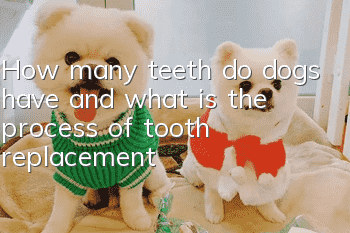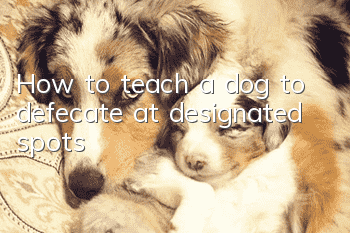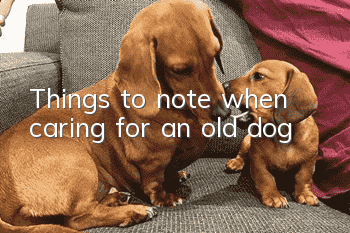How many teeth do dogs have, and what is the process of tooth replacement?

It is generally said that dogs change their teeth when they are four to six months old. To be more specific, they start to change their incisors (the incisors between the canine teeth on both sides of the middle of the mouth, a total of six) between two and four months old. At one month old, all the incisors are replaced with those of an adult dog, and the canine teeth are also replaced.
The condition of a dog’s teeth can also be used to determine the dog’s age. Specifically, you can refer to the following:
● Around 20 days: the dog starts to grow teeth;
● 4 to 6 weeks old: The dog’s milk incisors are all in line.
● When the dog is nearly 2 months old, all the dog’s deciduous teeth are in full length, white, thin and pointed;
● 2 to 4 months old: Dogs replace their first deciduous incisors;
●5 to 6 months old: Dogs begin to replace their second and third primary incisors and primary canines;
●After 8 months of age: All dogs have their permanent teeth replaced, but it is not ruled out that some dogs will have their permanent teeth later, and some dogs may even have their permanent teeth replaced at the age of 2;
●1 year old: The dog’s permanent teeth are all long, white and shiny, and there are sharp protrusions on the incisors;
●1.5 years old: The peak of the dog's first incisor tooth wears to the level of the smaller peak. This phenomenon is called peak obliteration;
●2.5 years old: The peak of the second incisor of the dog’s mandible is lost;
●3.5 years old: The peak of the dog’s first maxillary incisor is lost;
●4.5 years old: The peak of the second maxillary incisor of the dog is lost;
●5 years old: The peak of the third incisor of the dog's mandible is slightly worn, and the wear surface of the first and second incisors of the mandible is rectangular;
●6 years old: The peak of the third incisor of the dog's mandible is obliterated and the canine teeth are blunt and rounded;
●7 years old: The first incisor of the dog's mandible is worn to the root of the tooth, and the wear surface is vertically oval;
●8 years old: The first incisor of the dog’s mandible is worn and tilted forward;
●10 years old: The dog’s second mandibular second incisor and maxillary first incisor have a vertical oval wear surface;
●16 years old: The dog’s incisors have fallen out and the canine teeth are incomplete—the dog at this time is already a longevity star!
What is the difference between deciduous teeth and adult canine teeth?The deciduous teeth of dogs before they grow teeth are very small and thin, but very sharp. This is why it is easier for puppies to bite people. Adult canine teeth are larger and thicker than deciduous teeth, and are white in color. The incisors are closely arranged and the tips are rounder than deciduous teeth.
The teeth of adult dogs (permanent teeth) are: incisors, canines, premolars, and molars, a total of 42 teeth.
Puppy canine teeth are: incisors,There are 28 canine teeth and premolars in total. One premolar and molar are missing.
All canine teeth are short crown-shaped. The crowns of the first and second maxillary incisors are three-peaked, with a canine peak in the middle and small peaks on both sides. The remaining incisors each have two canine and small peaks. The canine teeth are curved conical shapes with sharp tips. It is a powerful weapon for offense and self-defense. The front teeth are three-dimensional. The sun teeth are multi-peaked.
What should you pay attention to when your dog’s teeth change?Be prepared in advance: As parents, after understanding that dog babies still have problems with tooth replacement, after three months, they must take precautions in advance for particularly serious dog chewing. Shoes, mats and other items that are easy for the dog to come into contact with and taste good should be put away as much as possible. Although furniture that cannot be chewed cannot be put away, once you see the dog chewing the furniture, you must stop it in time. If you really can't control it, When there is no one at home, you can consider temporarily locking it in a smaller space, such as a separate room with less furniture, or a cage. In addition, wires, power supplies, detergents and other things that may cause harm to dogs must be kept out of reach, because dogs in this period are crazy chewers. I have experienced this myself as soon as I enter the house. I discovered that one of the four pairs of shoes had been chewed up. Alas, it was useless to blame it. I could only blame myself for underestimating the destructiveness of dogs when their teeth change.
Reduce the pain of teething:
Dogs will also feel pain when their teeth change, so you can also find ways to help relieve the pain of teething. Some people say that you can let dogs chew ice cubes, but I personally feel that if it is not summer, it is not appropriate for puppies at this period to chew ice cubes, as it can easily cause diarrhea. But it is a good way to freeze a wet towel and then bite it on your dog. This will allow it to enjoy the cold, itching and pain relief without causing it to eat too much ice. You can try it.
Pay attention to the growth of new teeth:When a dog loses its teeth, it is a normal phenomenon that the fallen tooth cannot be found. It is very likely that the tooth was mixed with food and eaten, or it may have fallen somewhere. There is no need to worry about this. What you need to do is to observe the growth of new teeth every day. Sometimes a lot of new teeth grow in and the old teeth don't fall out. If it goes on for a long time, it will easily cause the new teeth to grow out of position and some problems with the gums. If it has an old tooth that won't fall out, for a well-behaved dog, you can try shaking the old tooth with a handle at home to help it fall out. If it doesn't work, just go to the doctor for help. They have special pliers. The tooth can be extracted easily and cheaply.
Pay attention to calcium supplement: This is the same as for people. When changing teeth, you need to pay attention to calcium supplement. In this way, your dog can have beautiful and strong permanent teeth!
When a dog grows to 4 to 5 months old, its small baby teeth will slowly fall out., new permanent teeth are about to emerge, and these little guys will become a little irritable because of the swelling and pain in their gums when teeth erupt. To ease their discomfort and help new teeth grow through their gums, they'll all be fond of nibbling, so don't be overly surprised if you come home to a mess. However, you cannot tolerate it blindly, as this will make it think that eating random things is the right thing to do and it is no big deal.
First of all, you can prepare some pet-specific toys for it to play with. In addition, it is also important to have clear rewards and punishments. If you see it eating something it shouldn’t, stop it immediately and severely punish it. Say "NO" or "No". On the contrary, if you see it playing with its toys obediently, please give it praise and encouragement. In this way, it will slowly develop a good habit of not eating randomly.
Secondly, the owner can let the puppy eat some small crushed ice cubes during the teething period. Otherwise, these things have a crispy texture, and can also numb the swollen and painful gums due to teething through the cold feeling. If your puppy has a weak stomach and cannot adapt to such exciting things, you can also use a wet towel with the end knotted and put it in the freezer of the refrigerator. After it freezes, take it out for the dog to chew on and play with. .
In addition, it is also a good way to prepare some delicious high-quality dog chews for dogs. These things made of bone glue and meat skin have just the right hardness and good taste. Dogs will soon transfer their energy from chewing furniture to chewing dogs. Glue it on top.
Notes
Dogs are very curious, and their curiosity is even more prominent during the molar period. Owners must be careful about the power cords at home. It is best to tape them to the floor, and be sure to take good care of the kitchen and bathroom. Door, keep all chemical cleaners out of your dog’s reach.
- What documents and conditions are needed to open a pet hospital?
- Nursing care for dogs during their recovery period
- Symptoms of canine distemper
- What is the personality of the Akita dog?
- Here’s everything you want to know about pet parasites!
- Owners need to make these preparations before a female dog gives birth
- What are the symptoms of Samoyed canine distemper?
- How to prevent hepatitis in dogs
- Why does the Welsh Terrier have red spots on its body?
- What are the symptoms of dog stones?



